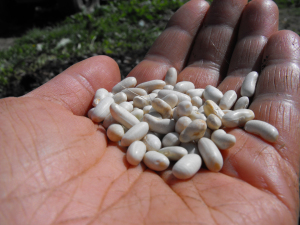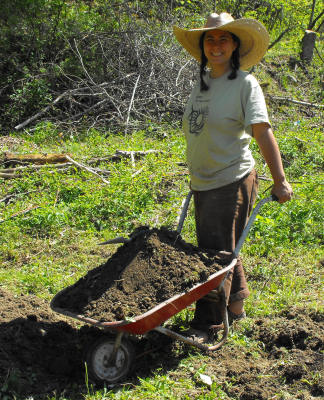
Spring planting
 Friday
was my reward for a long week spent
weeding and preparing the garden. I finally put out the first of
our tender vegetables, plants that can't bear the frost and that will
be coming up around the time of our frost free date. Reading
straight off my spreadsheet, I ended up planting in alphabetical order
--- basil, beans, cantaloupe, corn, cucumbers, garbanzos, okra,
peppers, quinoa, summer squash, urd beans, and watermelon. Even
tenderer plants will be hitting the dirt in a couple of weeks.
Friday
was my reward for a long week spent
weeding and preparing the garden. I finally put out the first of
our tender vegetables, plants that can't bear the frost and that will
be coming up around the time of our frost free date. Reading
straight off my spreadsheet, I ended up planting in alphabetical order
--- basil, beans, cantaloupe, corn, cucumbers, garbanzos, okra,
peppers, quinoa, summer squash, urd beans, and watermelon. Even
tenderer plants will be hitting the dirt in a couple of weeks.
 Even
though the 80 plus degree heat wore us
out fast, my Mexican sombrero let me keep moving long enough to slip
some summer flowers into gaps in the forest garden. Last year, I
finally threw flower seeds in the ground in June, and was stunned by how they
brightened my day in October. Mark points out that
with bees
in our lives, it only makes sense to take a few minutes and plant
flowers, so I raked back the mulch in a few sunny gaps and dropped in
seeds of Mexican sunflower, pink and white cosmos, zinnias, marigolds,
fennel, sunflowers of two varieties, a bumblebee
habitat mix (thanks, Jennifer!), and asters (thanks, Mom!) Except
for the last two, these are tried and true flowers that bear my neglect
admirably and bloom with no care from me.
Even
though the 80 plus degree heat wore us
out fast, my Mexican sombrero let me keep moving long enough to slip
some summer flowers into gaps in the forest garden. Last year, I
finally threw flower seeds in the ground in June, and was stunned by how they
brightened my day in October. Mark points out that
with bees
in our lives, it only makes sense to take a few minutes and plant
flowers, so I raked back the mulch in a few sunny gaps and dropped in
seeds of Mexican sunflower, pink and white cosmos, zinnias, marigolds,
fennel, sunflowers of two varieties, a bumblebee
habitat mix (thanks, Jennifer!), and asters (thanks, Mom!) Except
for the last two, these are tried and true flowers that bear my neglect
admirably and bloom with no care from me.
This is the first year
we're growing garbanzos, and the seed packet confused me. It told
me that garbanzos are a cool season crop like peas, and then combined
that with an admonition to plant them after the frost free date.
Um? Has anyone grown them? When did you plant them?
Want more in-depth information? Browse through our books.
Or explore more posts by date or by subject.
About us: Anna Hess and Mark Hamilton spent over a decade living self-sufficiently in the mountains of Virginia before moving north to start over from scratch in the foothills of Ohio. They've experimented with permaculture, no-till gardening, trailersteading, home-based microbusinesses and much more, writing about their adventures in both blogs and books.
Want to be notified when new comments are posted on this page? Click on the RSS button after you add a comment to subscribe to the comment feed, or simply check the box beside "email replies to me" while writing your comment.

Hi Anna,
I have grown garbanzos in the Pacific Northwest. I see no reason to wait until the last frost date because they are like peas. More like as soon as ground can be worked. Here, they are done by July, so their water needs match our climate exactly, as our rains stop for the season just when the garbanzos need to dry out.
Barbara